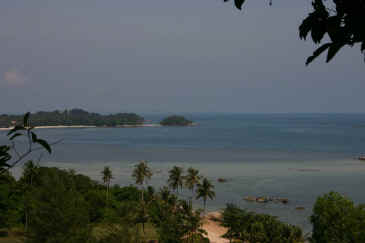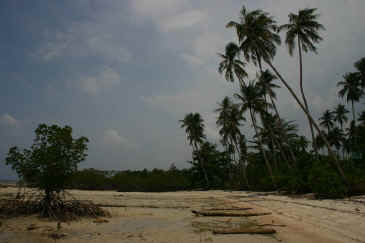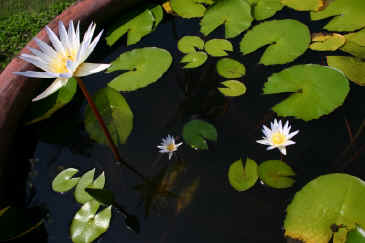|

Indonesia's Geography

Indonesia is the largest archipelago in the
world. It consists of five major islands and about 30 smaller groups. The
figure for the total number of islands is 17,508 according to the Indonesian
Naval Hydro-Oceanographic office. The archipelago is on a crossroads between
two oceans, the Pacific and the Indian ocean, and bridges two continents, Asia
and Australia. This strategic position has always influenced the cultural,
social, political and economic life of the country.
The territory of the Republic of Indonesia
stretches from 6o08' north latitude to 11o15' south
latitude, and from 94o45' to 141o05' east longitude. The
Indonesian sea area is four times greater than its land area, which is about
1.9 million sq. km. The sea area is about 7.9 million sq. km (including an
exclusive economic zone) and constitutes about 81% of the total area of the
country.
The five main islands are: Sumatra, which is
about 473,606 sq. km. in size; the most fertile and densely populated islands,
Java/Madura, 132,107 sq. km; Kalimantan, which comprises two-thirds of the
island of Borneo and measures 539,460 sq. km; Sulawesi, 189,216 sq. km; and
Irian Jaya, 421,981 sq. km, which is part of the world's second largest
island, New Guinea. Indonesia's other islands are smaller in size.
The archipelago is divided into three groups.
The islands of Java, Sumatra and Kalimantan, and the small islands in-between,
lie on the Sunda Shelf which begin on the coasts of Malaysia and Indo China,
where the sea depth does not exceed 700 feet. Irian Jaya which is part of the
island of New Guinea, and the Aru Islands lie on the Sahul Shelf, which
stretches northwards from the Australian coast. Here the sea depth is similar
to that of the Sunda Shelf.
Back to Top
Located between these two shelves is the island
group of Nusatenggara, Maluku and Sulawesi, where the sea depth reaches 15,000
feet. Coastal plains have been developed around the islands of Sumatra, Java,
Kalimantan and Irian Jaya.
The land area is generally covered by thick
tropical rain forests, where fertile soils are continuously replenished by
volcanic eruptions like those on the island of Java.
The country is predominantly mountainous with
some 400 volcanoes, of which 100 are active. Mountains higher than 9,000 feet
are found on the islands of Sumatra (Mt. Leuser and Mt. Kerinci), Java (Mt.
Gede, Mt. Tangkubanperahu, Mt. Ciremai, Mt. Kawi, Mt. Kelud, Mt. Semeru and
Mt. Raung), Sulawesi (Mt. Lompobatang and Mt. Rantekombala), Bali (Mt. Batur
and Mt. Agung), Lombok (Mt. Rinjani) and Sumbawa (Mt. Tambora). The highest
mountain is the perpetually snow-capped Mandala Top (15,300 feet) in the Jaya
Wijaya mountain range of Irian Jaya.
Many rivers flow throughout the country. They
serve as useful transportation routes on certain islands, for example, the
Musi, Batanghari, Indragiri and Kampar rivers in Sumatra; the Kapuas, Barito,
Mahakam and Rejang rivers in Kalimantan; and the Memberamo and Digul rivers in
Irian Jaya. On Java rivers are important for irrigation purposes, i.e., the
Bengawan Solo, Citarum and Brantas rivers.
A number of islands are dotted with scenic
lakes, like the Toba, Maninjau and Singkarak lakes on Sumatra; the Tempe,
Towuti, Sidenreng, Poso, Limboto, Tondano, and Matana lakes on Sulawesi; and
the Paniai and Sentani lakes on Irian Jaya.
Back to Top
CLIMATE AND WEATHER
The climate and weather of Indonesia is
characterized by two tropical seasons, which vary with the equatorial air
circulation (the Walker circulation) and the meridian air circulation (the
Hardley circulation). The displacement of the latter follows the north-south
movement of the sun and its relative position from the earth, in particular
from the continents of Asia and Australia, at certain periods of the year.
These factors contribute to the displacement and intensity of the
Inter-Tropical Convergence Zone (ITCZ) which is an equatorial trough of low
pressure that produces rain. Thus, the west and east monsoons, or the rainy
and dry seasons, are a prevalent feature of the tropical climate.
The Main Seasons
The climate changes every six months. The dry season (June to September)
is influenced by the Australian continental air masses; while the rainy season
(December to March) is the result of the Asian and Pacific Ocean air masses.
The air contains vapor which precipitates and produces rain in the country.
Tropical areas have rains almost the whole year through. However, the climate
of Central Maluku is an exception. The rainy season is from June to September
and the dry season from December to March. The transitional periods between
the two seasons are April to May and October to November.
Temperature and Humidity
Due to the large number of islands and mountains in the country, average
temperatures may be classified as follows:
coastal plains: 28oC
inland and mountain areas: 26oC
higher mountain areas: 23oC, varying with the altitude.
Being in a tropical zone, Indonesia has an average relative humidity between
70% and 90%, with a minimum of 73% and a maximum of 87%.
Back to Top
TERRITORIAL WATERS AND
EXCLUSIVE ECONOMIC ZONE
When independence was proclaimed and
sovereignty gained, Indonesia had to enact laws to govern the seas in
accordance with the geographic structure of an archipelagic state. This,
however, did not mean that the country would bar international passage. The
laws were necessary instruments for the unity and national resilience of the
country, with a territory that embraces all the islands, the islets and the
seas in between.
In view of the country's susceptibility to
foreign intervention from the sea and for domestic security reasons, on
December 13, 1957, the Indonesian Government issued a declaration on the
territorial waters of the Republic. It stated that all the waters surrounding
and between the islands in the territory came within Indonesia's sovereignty.
It also determined that the country's territorial water limit was 12 miles,
measured from a straight baseline drawn from the outermost points of the
islands.
In the past, archipelagic states like Indonesia
have unilaterally determined their 200-mile-Exclusive Economic Zones. Today
such economic zones are confirmed by the International Convention on the Law
of the Sea, which was ratified by the Indonesian Government on October 18,
1983, by Act No. 5 of the same year. This is the legal basis of the
Indonesian-Exclusive Economic Zone.
Back to Top

FLORA
The rich flora of Indonesia includes many
unique varieties of tropical plant life in various forms. Rafflesia arnoldi,
which is found only in certain parts of Sumatra, is the largest flower in the
world. This parasitic plant grows on certain lianas but does not produce
leaves. From the same area in Sumatra comes another giant, Amorphophallus
tatinum, the largest inflorescence of its kind.
The insect trapping pitcher plant
(Nepenthea spp) is represented by different species in many areas of western
Indonesia.
The myriad of orchids is rich in species,
varying in size from the largest of all orchids, the tiger orchid or
Grammatophyllum Speciosum, to the tiny and leafless species of Taeniophyllum
which is edible and taken by the local people as a medicine and is also used
in handicrafts. The forest soil is rich in humus which enables the luxuriant
growth of a multitude of fungi, including the horse hair blight, the
luminescent species, the sooty mold and the black mildew.
Indonesia's flora also abounds in timber
species. The dipterocarp family is renowned for its timber (meranti),
resin, vegetable oil and tengkawang or illipe nuts. Ramin, a good-quality
timber for furniture, is produced by the Gonystylus tree. Sandalwood, ebony,
ulin and Palem-bang timber are other valuable forest products. Teakwood is a
product of man-made forests in Java.
Because the flora is so rich many people in
Indonesia have made a good living of this natural resource. About 6,000
species of plants are known to be used directly or indirectly by the people. A
striking example in this modern time is the use of plants in the production of
traditional herbal medicine or "Jamu". Flowers are indispensable in
ceremonial, customary and traditional rites.
To care for animals and plants in the country,
the fifth of November was designated as the national Flora and Fauna Day. To
foster the society's love for its fauna and flora, the Komodo reptile (Varanus
komodoensis) has been designated as Indonesia National Animal, the red
freshwater Liluk/arwana (Scleropage formosus) as the Fascinating Animal
and the flying Elang Jawa (Javan Hawk Eagle, Spizaetus bartelsi) as the
Rare (endangered) species. These decisions complement the previous designation
of Indonesia's national flowers.

Back to Top
INDONESIA STANDARD
TIME
As of January 1, 1988, Indonesia's three time
zones have been changed as below:
- Western Indonesia Standard Time equals GMT
plus 7 hours (meridian 105oE), covering all provinces in
Sumatra and Java, and the provinces of West and Central Kalimantan.
- Central Indonesia Standard Time equals GMT
plus 8 hours (meridian 120oE), covering the provinces of East
and South Kalimantan, all provinces in Sulawesi, and the provinces of
Bali, West and East Nusatenggara and East Timor.
- Eastern Indonesia Standard Time equals GMT
plus 9 hours (meridian 135oE), covering the provinces of Maluku
and Irian Jaya.
Back to Top
Information provided by the Directorate
of Foreign Information Services, Department of Information, Republic of
Indonesia.
|
Location:
|
|
Southeastern
Asia, archipelago between the Indian Ocean and the
Pacific Ocean
|
|
|
Geographic
coordinates:
|
|
5 00 S, 120 00
E
|
|
|
Area:
|
|
total: 1,904,569
sq km
country
comparison to the world: 16
land: 1,811,569
sq km
water: 93,000
sq km
|
|
|
Area -
comparative:
|
|
slightly less
than three times the size of Texas
|
|
|
Land
boundaries:
|
|
total: 2,830
km
border
countries: Timor-Leste
228 km, Malaysia 1,782 km, Papua New Guinea 820 km
|
|
|
Coastline:
|
|
54,716 km
|
|
|
Maritime
claims:
|
|
measured from
claimed archipelagic straight baselines
territorial
sea: 12
nm
exclusive
economic zone: 200
nm
|
|
|
Climate:
|
| Current
Weather
tropical; hot,
humid; more moderate in highlands
|
|
|
Terrain:
|
|
mostly coastal
lowlands; larger islands have interior mountains
|
|
|
Elevation
extremes:
|
|
lowest point: Indian
Ocean 0 m
highest point: Puncak
Jaya 5,030 m
|
|
|
Natural
resources:
|
|
petroleum, tin,
natural gas, nickel, timber, bauxite, copper,
fertile soils, coal, gold, silver
|
|
|
Land use:
|
|
arable land: 11.03%
permanent
crops: 7.04%
other: 81.93%
(2005)
|
|
|
Irrigated
land:
|
|
45,000 sq km
(2003)
|
|
|
Total
renewable water resources:
|
|
2,838 cu km
(1999)
|
|
|
Freshwater
withdrawal (domestic/industrial/agricultural):
|
|
total: 82.78
cu km/yr (8%/1%/91%)
per capita: 372
cu m/yr (2000)
|
|
|
Natural
hazards:
|
|
occasional
floods; severe droughts; tsunamis; earthquakes;
volcanoes; forest fires
volcanism: Indonesia
contains the most volcanoes of any country in the
world - some 76 are historically active;
significant volcanic activity occurs on Java,
western Sumatra, the Sunda Islands, Halmahera
Island, Sulawesi Island, Sangihe Island, and in
the Banda Sea; Merapi (elev. 2,968 m, 9,737 ft),
Indonesia's most active volcano and in eruption
since 2010, has been deemed a "Decade
Volcano" by the International Association of
Volcanology and Chemistry of the Earth's Interior,
worthy of study due to its explosive history and
close proximity to human populations; other
notable historically active volcanoes include
Agung, Awu, Karangetang, Krakatau (Krakatoa),
Makian, Raung, and Tambora
|
|
|
Environment
- current issues:
|
|
deforestation;
water pollution from industrial wastes, sewage;
air pollution in urban areas; smoke and haze from
forest fires
|
|
|
Environment
- international agreements:
|
|
party to: Biodiversity,
Climate Change, Climate Change-Kyoto Protocol,
Desertification, Endangered Species, Hazardous
Wastes, Law of the Sea, Ozone Layer Protection,
Ship Pollution, Tropical Timber 83, Tropical
Timber 94, Wetlands
signed, but not
ratified: Marine
Life Conservation
|
|
|
Geography -
note:
|
|
archipelago of
17,508 islands (6,000 inhabited); straddles
equator; strategic location astride or along major
sea lanes from Indian Ocean to Pacific Ocean
|
|








